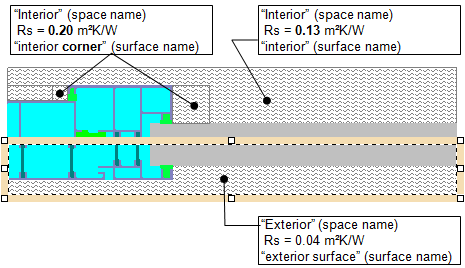The Space (Room) and the Surface
While defining the modelled building component the entry of spaces (rooms) are the core part of the input, especially the input thermal transfer resistance Rsi and Rse [mēK/W] (or thermal transfer coefficients αsi und αse [W/mēK] ) of their surfaces appropriate to a designated situation (e.g. "exterior", "interior/along glass", etc.).
Spaces at boundaries of a component are defined as "air-filled" elements of equal temperature (and relative humidity); in the sense described here, exterior air is to be treaded as a "space" too.
Distinctive spaces are identified by their unique names (Space Name, e.g. "exterior", "interior", etc.). A single space must later (not in input, but in the evaluation branch) be assigned one, unique temperature condition (and eventually relative humidity).
The "space" as described here need not be locally coherent but it shall be composed of intentionally separated areas; If all such areas receive identical space name they will be treated as one, coherent, space.
Surfaces of different spaces shall not be connected directly to each other, i.e. without placing some material construction interconnecting them.
The space may, however, be divided into several elements to account for different surface situations within the space. Such "sub-spaces" can then be identified with different transfer resistance (or transfer coefficient) values (surface property) but sharing common space name.

See also: Elements of the building component, Element overlapping, The heat source (power source), Element type (kind/type of a element)